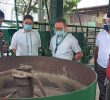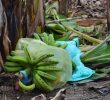DAVAO CITY, Philippines — The Development Bank of the Philippines (DBP) is aiming to do more in Southern Mindanao where it earmarked close to P2 billion for investors this year in the area.
DBP president and chief executive officer Reynaldo G. David who met with the Davao Region businessmen including those from other parts of Mindanao during an investor�s presentation in coordination with the Davao City Chamber of Commerce and Industry, Inc. (DCCCI) said they want to be part on more development projects that would guarantee more jobs.
He said the bank�s thrust focuses on priority programs namely micro, small and medium enterprises, environment, social services and logistics and infrastructure.
He also said that DBP is encouraging more investments for its flagship project; Sustainable Logistics and Development Program (SLDP) that aims to modernize the processing, storage, delivery and distribution of grains harvests and perishable goods of traders and farmers from Mindanao to Luzon. The SLDP has three components: the Ro-Ro Terminal System (RRTS), Cold Chain and Grains Highway.
But despite the availability of funding, David admitted there are still low takers but hopefully investments would peak up especially in the Southern part.
�I don�t know what is happening to Davao that is why we wanted to do more as we want to work with you together,� he said.
David said they hope that after the roadshow with businessmen having a clear view of DBP�s direction there would be more projects.
�The Philippines is having good economic stand and that can�t be stopped, it is there and we are willing to support projects especially in Mindanao,� he said.
David cited for instance that for the P7.7 billion loan issuances in 2007, P910 million goes to Mindanao but only P108 million with 133 projects are from Davao.
He said what they are pushing for SLDP projects is the Roll-on, Roll-off (RORO) system and it has liberalized its credit terms to make its facilities more accessible to ship owners. Interest rate for loans for acquisition of RORO vessels in the missionary connections is seven percent per annum for the first two years, while the succeeding rates will be based on Philippine Dealing System Treasury Rates. Collateral will be the vessel itself.
He said that in the Visayas two years ago, no one wanted to take the Roxas-Caticlan as possible investment but because of the increase in tourist investors towards Boracay, investors are now fighting for slots.
He said there is a market for passage and freight, and there is huge potential for growth in the sectors of agriculture, manufacturing, trade, transportation, and tourism and what is needed is the vessel to open the nautical bridge.
The missionary routes he said will complement the existing nautical highways, namely, the central, western, and eastern seaboards. The western highway runs from Manila in the north to Dapitan in the south. The eastern highway runs from Manila all way to Davao, while the Central seaboard cuts from Manila to major destinations like Masbate, Leyte, Cebu, Bohol, Cagayan de Oro, and Davao. (PIA XI/prixdbanzon).










